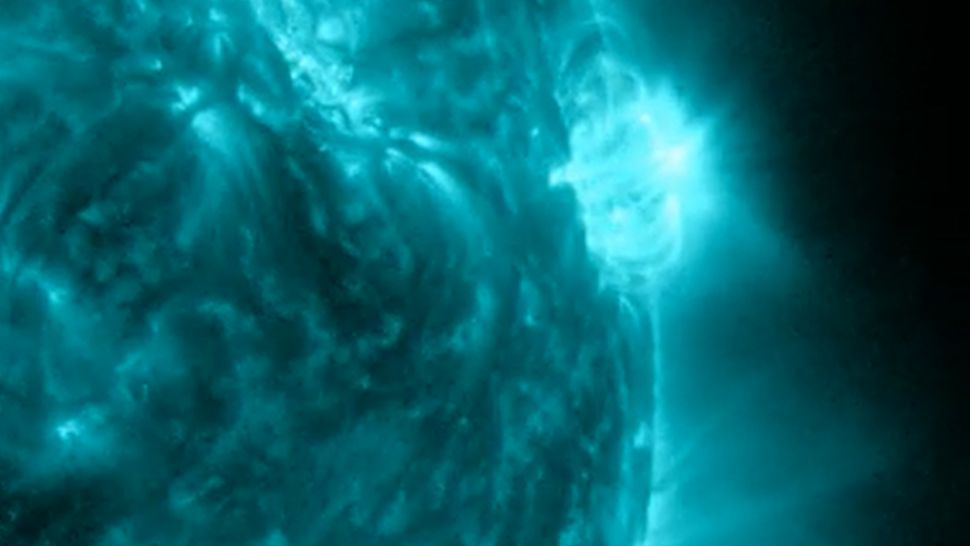Description

Disclaimer: Copyright infringement not intended.
Context
A significant solar event that occurred on Monday, August 7, resulting in the disruption of radio and navigation signals across North America.
Details
- A powerful solar flare disrupted radio and navigation signals across North America on August 7.
- Space weather forecasters issued warnings due to energetic particles hitting Earth.
Solar Flare Classification and Cycle
- The flare was classified as an5, the 20th X flare in the current 11-year solar cycle.
- Solar flares are energetic radiation bursts from magnetically dense sunspot regions.
- X flares are the most potent solar flare category.
- The solar cycle is set to reach its maximum next year.
Solar Flare Mechanics
- Flares originate from cool, magnetically dense sunspots.
- Photons from flares reach Earth in eight minutes at the speed of light.
- Flare radiation interacts with particles in Earth's ionosphere (altitude: 50-400 miles).
- Interaction supercharges ionosphere particles, affecting radio and satellite signals.
Impact of the X1.5 Flare
- The X1.5 Flare caused an R3 (strong) radio blackout event on the daylit side of Earth.
- Affected regions included most of the US, Canada, and the Pacific Ocean.
- Frequencies below 5 MHz were most affected, degrading navigation signals.
Sunspot Activity and Recent Flares
- The flare erupted from the largest, most active sunspot group visible on the sun's disk.
- Occurred just two days after a somewhat weaker X flare on August 5.
- Multiple moderate-class flares were also observed recently, with three in the past 24 hours.
Solar Radiation Storm Warning
- The Met Office warned of a mild solar radiation storm due to charged solar particles.
- Solar flares contributed to the presence of charged particles in Earth's atmosphere.
- Potential radiation hazard to astronauts, aircraft passengers, crew, and satellites.
- Current event classified as a mild category 1, likely harmless.
Future Solar Flare Predictions
- The Met Office predicts potential strong flares as the sunspot cluster remains visible.
- The threatening region is expected to move behind the sun's edge in the next two days.
Coronal Mass Ejections (CMEs) and Geomagnetic Storms
- Experts anticipate the arrival of two CMEs, magnetized gas clouds escaping from the sun.
- CMEs can cause geomagnetic storms by interacting with Earth's magnetic field.
- Geomagnetic storms lead to beautiful aurora displays and atmospheric swelling.
- Severe storms can disrupt power grids and telecommunication networks.
- com forecasts a potential strong G3-level geomagnetic storm from the upcoming CME.

About Solar Flares
- Solar flares are intense bursts of energy and radiation originating from the sun's surface.
- These explosions release a tremendous amount of electromagnetic radiation, including X-rays and ultraviolet light.
Sunspots and Magnetic Activity
- Solar flares typically originate from magnetically active regions on the sun's surface known as sunspots.
- Sunspots are cooler and more magnetically dense areas compared to their surroundings.
Energetic Particle Acceleration
- Flares result from the sudden release of magnetic energy stored in the sunspot's magnetic fields.
- Magnetic reconnection, a process where magnetic fields rearrange and realign, accelerates charged particles.
Classification of Solar Flares
- Solar flares are categorized based on their X-ray intensity, measured in X-ray flux units (Watts per square meter).
- The classification scale includes A, B, C, M, and X classes, with X being the most powerful.
Impact and Effects
- Solar flares can cause radio and communication disruptions on Earth due to ionospheric disturbances.
- High-energy particles from flares can interfere with satellite operations and damage sensitive electronics.
Solar Flare Prediction and Monitoring
- Space weather forecasters use satellite observations to monitor sunspots and solar activity.
- Prediction models help estimate the potential impact of flares on Earth's technology and infrastructure.
Interaction with Earth's Atmosphere
- Flare radiation reaches Earth in about eight minutes, traveling at the speed of light.
- Radiation interacts with particles in Earth's ionosphere, leading to ionization and disturbances.
Auroras and Geomagnetic Storms
- Geomagnetic storms can result from interactions between solar flares and Earth's magnetic field.
- These storms lead to stunning aurora displays at high latitudes.
Space Weather Hazards
- Severe solar flares and associated geomagnetic storms can disrupt power grids and communication systems.
- Astronauts in space or passengers on polar flights could be exposed to increased radiation levels.
Preparedness and Mitigation
- Organizations like the National Oceanic and Atmospheric Administration (NOAA) provide space weather alerts.
- Measures such as adjusting satellite operations and power grid management help mitigate potential impacts.
Solar Flares and Technological Society
- Solar flare research and monitoring play a crucial role in protecting modern technology-dependent societies.
- Continued study helps us understand solar dynamics and develop strategies to minimize potential disruptions.
|
PRACTICE QUESTION
Q) Discuss the impact and significance of powerful solar flares on Earth's technological infrastructure and communication systems. (150 words)
|
.jpg)
https://www.space.com/x-class-solar-flare-radio-blackout-august-2023











